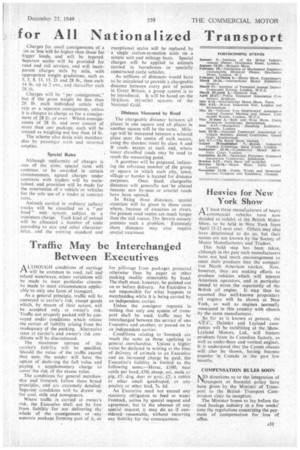Common Charges Schem for All Nationalized Transport
Page 32

Page 33

If you've noticed an error in this article please click here to report it so we can fix it.
B.T.C. Abandons Principle of Charging What the Traffic Will Bear
UNDER the new freight charges scheme to be devised by the British Transport Commission, classifications of merchandise, conditions of carriage, regulations and chargeable distances will, as far as possible, be common to rail, road and inland waterways. "Charges for the respective forms of transport may, however, differ, but should be so framed as to encourage traffic towards the service which can convey it most conveniently and economically," says the Commission.
The old railway system of charging what the traffic will bear is to be discontinued. Instead, in establishing classifications and scales of rates, handling characteristics of goods will be the main consideration, and value will become of minor importance. Mileages between points will be calculated on road distances.
Details of the scheme, including conditions of carriage, are contained in "Draft Outline of Principles Proposed to be Embodied in a Charges Scheme for Merchandise Traffic," published by the B.T.C. at Is.
Discussion With Traders Shortly
The booklet has been prepared for he information and convenience of traders and will serve as a basis of discussions between them and the B.T.C. early in the New Year. At present, the transport of coal, coke and patent fuel is excluded from the draft. These commodities will be dealt with later, probably in the same scheme.
In general, traffic will be conveyed at carrier's risk, although a few commodities which are particularly vulnerable to damage will be handled only at owner's risk. Carrier's liability will be limited unless the full value is declared and a premium paid for the excess value.
When complete, the scheme will be submitted to the Transport Tribunal. It will then be considered by the Tribunal at a public inquiry open to alt representative bodies which may wish to be heard.
At a Press conference, last week, Sir Cyril Hurcomb, chairman of the R.T.C., said it was unlikely that the scheme would go to the Tribunal for at least 12 months. Discussions before the Tribunal would occupy a further period of months.
Sir Cyril refused to commit himself on the rates ultimately to be fixed, or to draw comparisons between the probable charges for road and rail transport. He said that the form of the scheme for passenger fares, which is to be prepared later, would not be prejudiced by the scheme for freight rates. Charges for small consignments of a :on or less will be higher than those for bigger loads, and will he tapered. Separate scales will be provided for road and rail services, and will incorporate charges mile by mile, with appropriate weight gradations, such as 3, 5, 8, 11, 15. 21 and 28 lb., then each 14 lb. uP to 2 cwt., and thereafter each 28 lb.
Charges will be "per consignment,hut if the gross weight he less than 28 lb. each individual article will rate as a separate consignment, unless it is cheaper to charge as for a consignment of 28 lb. or over. Where consignments of 28 lb. and over consist of more than one package, each will be treated as weighing not less than 14 lb.
The scheme also deals with merchandise by passenger train and returned empties.
special Rates Although uniformity of charges is one of the aims, special rates will continue to be awarded in certain circumstances, agreed charges under contracts with traders will be maintained, and provision will be made for the reservation of a vehicle or vehicles for the sole use of a trader at contract rates.
Animals carried in ordinary railway trucks will be classified on a " per head" unit system, subject to a minimum charge. Each kind of animal will be allocated a number. of units according to site and other characteristics, and the existing standard and
exceptional scales will be replaced by a single station-to-station scale on a simple unit and mileage basis. Special charges will be applied to animals carried in horseboxes or specially constructed cattle Vehicles.
As millions of distances would have to be calculated to provide a chargeable distance between every pair of points in Great Britain, a group system is to be introduced. It will he based on the 10-kilorn. (6i-mile) squares of the National Grid.
Distance Measured by Road
The chargeable distance between all places in one square and all places in another square will be the same. Mileage will be measured between a selected place near the centre of each square, using the shortest route by class A and 13 roads, except at each end, where lower classified roads may be used to reach the measuring point. • A gazetteer will be prepared, indicating the reference number of the group• or square in which each city, town, village or hamlet is located for distance purposes. Once fixed, chargeable distances will generally not be altered because new by-pass or arterial roads have been opened.
In fixing these distances, special attention will be given to those cases where, because of estuaries or rivers, the present road routes are much longer than the rail routes. The Severn estuary presents such a prohleni. Extremely short distances may also require special treatment,




















































































